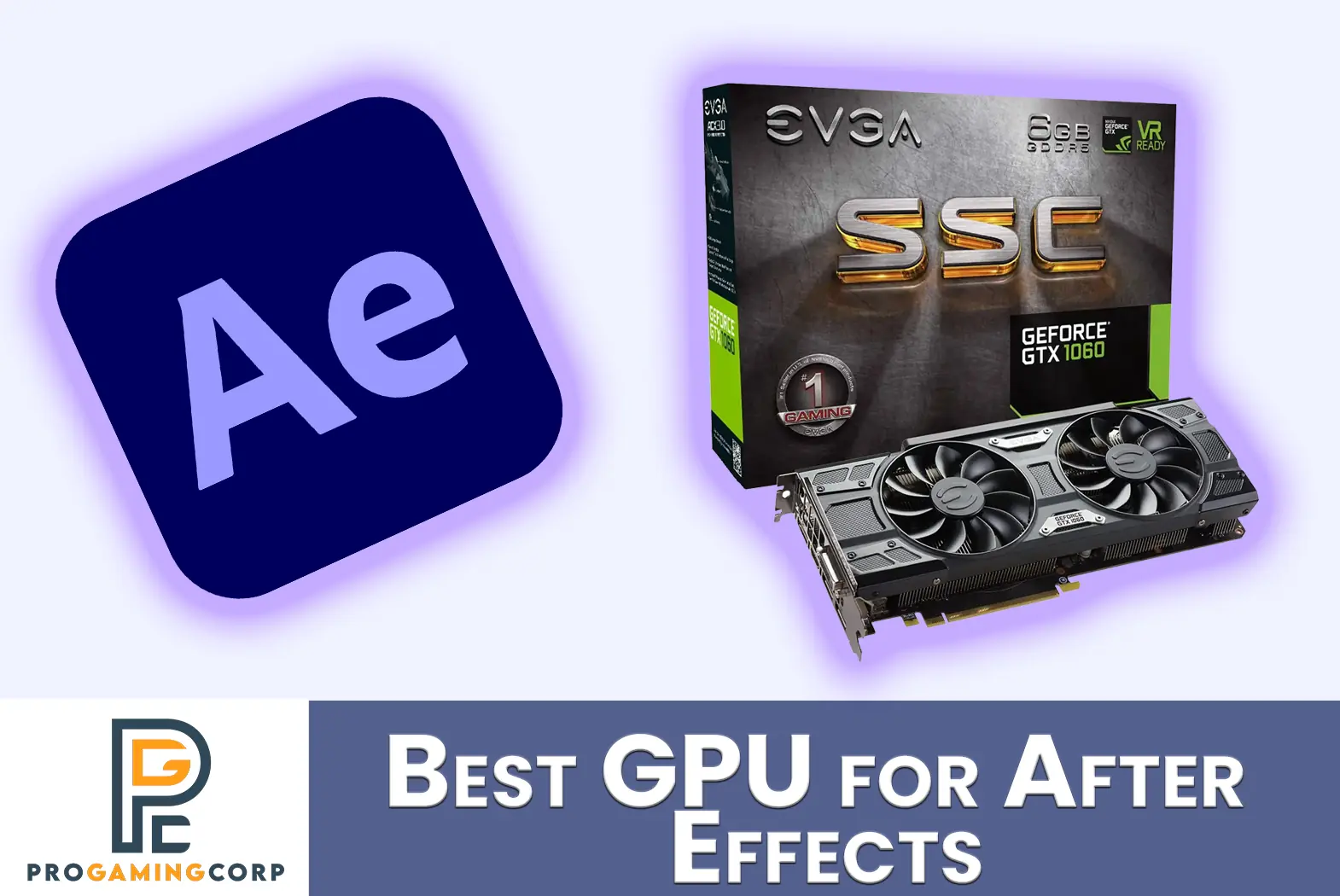Adobe After Effects is one of the most popular video editing and motion graphics software used by professionals all over the world. It allows users to add stunning visual effects and animations to their video projects. However, to take full advantage of After Effects and work efficiently, you need a powerful computer with a strong graphics processing unit (GPU).
The GPU is responsible for rendering images and processing visual effects and animations in After Effects. A more powerful GPU can significantly speed up render times and improve overall performance. This allows you to work faster and be more productive.
In this comprehensive guide, we will discuss everything you need to know about choosing the best GPU for After Effects in 2023. We will go over the top graphics cards from Nvidia and AMD, understand how After Effects utilizes the GPU, optimal VRAM requirements, and other factors to consider.
Contents
How After Effects Uses the GPU
Before we look at specific GPU recommendations, it’s important to understand how After Effects utilizes the graphics card. Here are some key points:
- After Effects relies heavily on the CPU for most operations, including rendering. The GPU is used for processing effects and features that are GPU-accelerated.
- GPU-accelerated effects include blurs, distortions, fractal noise, particles, etc. These will render much faster with a powerful GPU.
- The GPU enables multi-frame rendering in After Effects which allows distributing a render across multiple frames simultaneously.
- Higher VRAM allows After Effects to process more frames in parallel during multi-frame rendering.
- The GPU is vital for real-time previews. A good GPU will provide smoother interactive previews.
While the CPU does most of the heavy lifting, the role of the GPU is still important for efficient workflow. Next, let’s see how much VRAM you need.
Optimal VRAM for After Effects
VRAM (video memory) determines how much data can be processed on the graphics card at once. For After Effects, a higher VRAM allows rendering more frames simultaneously.
Here are the recommended VRAM requirements for different scenarios:
- 4GB VRAM – Suitable for HD and lower resolution projects. Will be limited in multi-frame rendering.
- 6GB VRAM – Allows more complex HD projects and decent multi-frame rendering.
- 8GB VRAM – The sweet spot for most users. Enables smooth 4K edits and compositing.
- 11GB+ VRAM – Recommended for 4K+ projects, 3D graphics, VR content and multi-frame rendering across high resolution timelines.
Higher VRAM also enables longer RAM previews in After Effects for smoother editing workflow.
Now let’s look at the best graphics cards for After Effects in 2023 at various price points.
Best GPUs for After Effects in 2023
1. NVIDIA RTX 4090 – The Ultimate GPU for After Effects
The brand new Nvidia RTX 4090 is currently the fastest graphics card available and the best choice for running After Effects smoothly. Here are its key features:
- 24GB GDDR6X VRAM – Massive amount for complex animations and 8K+ projects
- Up to 2.5x faster performance over previous generation RTX 3090
- DLSS 3 boosts frame rates during renders and live previews
- Great for GPU accelerated effects and multi-frame rendering
- Powerful enough for VR, 3D and motion graphics work
With the RTX 4090, you can expect buttery-smooth live previews in After Effects even with multiple 4K or 8K layers and effects. Renders will fly by rapidly. The only downside is the very high price of over $1,599.
2. NVIDIA RTX 3090 Ti – Excellent Alternative to RTX 4090
If the RTX 4090 is out of your budget, the previous generation RTX 3090 Ti is an excellent alternative with 24GB VRAM. Some of its capabilities:
- 24GB GDDR6X VRAM handles complex compositions easily
- Great for 4K, 6K and 8K projects as well as VR/3D content creation
- DLSS support increases rendering speeds
- Can multi-frame render high resolution timelines smoothly
Performance is around 10-15% lower than RTX 4090 but Still formidable for After Effects. Available for under $1,200 which makes it very capable value.
3. AMD Radeon RX 6900 XT – AMD Alternative to RTX 3090 Ti
For an AMD option that competes with the RTX 3090 Ti, the Radeon RX 6900 XT is an excellent graphics card for After Effects with 16GB VRAM. Key highlights:
- 16GB VRAM handles complex animations, 3D graphics and high resolution footage well
- Great performance for GPU accelerated effects
- Enables smooth real-time previews of motion graphics
- Good for DaVinci Resolve and other video editing software too
The RX 6900 XT has slightly lower performance than the RTX 3090 Ti but much more affordable at around $700. Overall an excellent professional AMD GPU for animators and video editors.
4. NVIDIA RTX 3080 12GB – Great Value for Performance
The RTX 3080 12GB card delivers excellent performance for After Effects at a more reasonable price point than the top-tier options. Here are its advantages:
- 12GB VRAM tackles complex animations and multi-layered 4K timelines well
- DLSS boosts rendering speeds and preview performance
- Capable of GPU accelerated effects and multi-frame rendering
- Quiet and efficient cooling for long render sessions
Priced around $800, the RTX 3080 12GB gives you great bang for buck value while having enough VRAM for smooth 4K and even 6K workflows in After Effects.
5. NVIDIA RTX 3070 Ti – Excellent Mid-range Choice
In the mid-range segment, the RTX 3070 Ti is our pick for After Effects users with its combination of 8GB VRAM and new rendering technologies:
- 8GB VRAM suitable for 4K edits, animations and moderate 3D work
- DLSS accelerates rendering and improves preview performance
- Good for basic multi-frame rendering and GPU accelerated effects
- Quiet dual-fan cooler keeps temps low during longer renders
For around $600, the RTX 3070 Ti gives superb price to performance ratio for 1080p and 1440p content creators. It can handle 4K too but you may need to limit complex composites.
6. AMD Radeon RX 6700 XT – Mid-range AMD Pick
On the AMD side, the Radeon RX 6700 XT is the mid-range alternative to the RTX 3070 Ti for After Effects users who don’t need more than 8GB VRAM:
- 12GB VRAM suitable for most 4K and 1440p projects
- Great performance for GPU accelerated effects in AE
- Can handle moderate multi-frame rendering
- Advanced cooling for smooth long renders
For a price around $450, the RX 6700 XT delivers very good 1080p and 1440p performance in After Effects. It can tackle simpler 4K edits too. The extra 4GB VRAM gives it an edge over RTX 3070 Ti.
7. NVIDIA RTX 3060 Ti – Budget Pick with 8GB VRAM
If you’re looking for an even more affordable GPU, the RTX 3060 Ti is our budget pick for After Effects:
- 8GB VRAM adequate for Full HD and 1440p content
- Good entry-level GPU accelerated effect performance
- DLSS can boost render speeds when enabled
- Quiet dual-fan cooler keeps card running smooth during renders
Priced around $400, the RTX 3060 Ti is the most affordable card with 8GB VRAM. It can handle less complex 4K edits too. Overall great value for money.
8. AMD Radeon RX 6600 – Budget AMD Pick
From AMD, the Radeon RX 6600 is a great budget choice for Full HD After Effects workflows with its 8GB memory:
- 8GB VRAM suitable for 1080p and 1440p projects
- Decent performance for GPU accelerated effects on a budget
- Can handle less complex 4K timelines as well
- Quiet cooling performance ideal for longer rendering
Available for around $260, the RX 6600 gives you just enough muscle for casual After Effects work with smooth Full HD workflow. It’s also very quiet and efficient.
Other Factors to Consider
CPU Performance
While we’ve focused on GPUs in this guide, the CPU is also crucial for After Effects performance. A powerful processor with high core counts like Intel Core i7/Core i9 or AMD Ryzen 7/Ryzen 9 is recommended. After Effects relies heavily on single core performance so CPUs with good per core speeds are ideal.
SSD Storage
Your storage drive also impacts performance in After Effects. Using fast NVMe SSD storage allows for faster read/write speeds when working with cached previews, exports and large source files. This improves overall workflow and preview smoothness.
RAM Capacity
Having adequate RAM capacity (32GB or higher) allows After Effects to process larger content and handle complex compositions with multiple layers, effects and 3D elements smoothly.
People Also Ask
Does After Effects use GPU or CPU?
After Effects relies more on CPU performance but also utilizes the GPU in important ways. The GPU handles rendering GPU accelerated effects faster. It also enables multi-frame rendering to boost render speeds. For previews, a powerful GPU gives you smoother interactive performance.
How much VRAM do I need for After Effects?
8GB VRAM is recommended for most After Effects workflows involving Full HD to 4K footage. For advanced 6K, 8K projects, 3D graphics and VR content, you will benefit from GPUs with 11GB+ VRAM. Higher VRAM allows more multi-frame rendering.
Is an NVIDIA or AMD GPU better for After Effects?
Both Nvidia and AMD make capable GPUs for After Effects. However, Nvidia currently has more graphics cards optimized for creative workloads like the RTX 30-series and new RTX 40-series GPUs. These offer excellent performance for GPU accelerated effects and multi-frame rendering.
What is the minimum GPU for After Effects?
The minimum GPU for After Effects is a DirectX 11 capable card with at least 1GB VRAM. Realistically, you will want at least 2GB VRAM for Full HD footage and 4GB+ VRAM for higher resolution 4K+ projects for a smoother experience.
Does After Effects require multiple GPUs?
After Effects works well even with a single powerful GPU like the RTX 3080 or RX 6800 XT. It does not require multiple GPUs, unlike some 3D rendering software. One capable GPU is sufficient for most users’ needs.
Conclusion
The right GPU can significantly speed up your After Effects workflow and allow working with complex projects easily. The Nvidia RTX 4090 is currently the fastest graphics card available and highly recommended if you need top-tier performance. For most users, the previous generation RTX 3090 Ti or RTX 3080 deliver the best balance of performance and value.
On the AMD side, the Radeon RX 69000 XT and RX 6700 XT are excellent GPU choices for After Effects. For budget systems, the Nvidia RTX 3060 Ti and AMD Radeon RX 6600 offer decent entry-level options.
Along with a capable GPU, also ensure your CPU, RAM and SSD storage are up to speed to handle After Effects smoothly. With the right hardware, you can get the best out of this powerful motion graphics and VFX software from Adobe.

